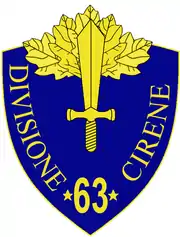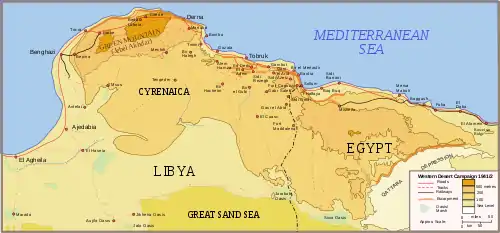63rd Infantry Division Cirene
The 63rd Infantry Division Cirene was an auto-transportable infantry division of the Italian Army during World War II. The Cirene Division was formed 1 October 1937 in Marj and destroyed 5 January 1941 in Bardia. (Operation Compass) in January 1941.[1] The Cirene was classified as an auto-transportable division, meaning staff and equipment could be transported on cars and trucks, although not simultaneously.
| 63rd Infantry Division Cirene | |
|---|---|
 63rd Infantry Division Cirene Insignia | |
| Active | 1939–1941 |
| Country | Italy |
| Branch | Italian Army |
| Type | Infantry |
| Size | Division |
| Nickname(s) | Cirene |
| Colors | red on left, blue on right |
| Engagements | World War II |
| Commanders | |
| Notable commanders | Gen. D. Carlo Spatocco Gen. B. Alessandro De Guidi |
Action

By 10 June 1940, the Cirene division was stationed at Al Adam (now Tobruk Airport), with the rear areas protection duty. In the August, 1940, it was transferred to the Sallum-Bardia front area. The Italian invasion of Egypt has started 9 September 1940. 13 September 1940 the Cirene division also started to participate, entering Egyptian territory 13 September 1940 and reaching Sidi Barrani on 16 September 1940. Afterward, the Italian Army formed a defensive line composed of big outposts separated by wide desert areas. At the southern end of the line was the Buqbuq sector, where the Cirene Division has fortified in four strong points around the rocky hill near Ābār Abū Safāfī (Bir Sofafi), ‘Alam ar Rābiyah (Alam Rabia), the crossroads at point 236 31°11.33′N 25°33.14′E, the crossroads at Qabr el Mahdi (Qabe Mahdi) and point 226 near Ābār Abū Safāfī (Bir Sofafi). They were separated from the next formation to the north, the Maletti Group by a 30 km (19 mi) gap.[2] The opening stage of the British counter-attack Operation Compass was known by the Italians as the "Battle of the Marmarica" after the name of the coastal plain where the battle was fought.[3] The British knew it as the "Battle of the Camps" after the individual Italian camps set up in a defensive line outside of Sidi Barrani. On 11 December 1940, a patrol from British 7th Support Group entered Rabia to find it empty. The Cirene Division had withdrawn from there and Ābār Abū Safāfī (Sofafi) overnight.[4] An order to the withdrawing 4th Armoured Brigade to cut them off west of Ābār Abū Safāfī (Sofafi) arrived too late and they were able to make their way along the top of the escarpment to link with Italian forces at Naqb al Ḩalfāyah during general retreat to Sallum. The losses during 11–14 December 1940 retread were moderate to severe.[5][6]
By 15 December the Italian commander Annibale Bergonzoli had approximately 40,000 defenders under his command. But situation has deteriorated rapidly due heavy aerial bombardment and further Allied attacks. The Italian divisions defending the perimeter of Sallum to Bardia included remnants of the Cirene, the 62 Infantry Division Marmarica, the 1 Blackshirt Division 23 Marzo, and the 2 Blackshirt Division 28 Ottobre. At first, the Cirene division guarded Marsá al Murayghah (Mrega) zone which was a part of an 18-mile (29 km) perimeter which had a permanent anti-tank ditch, extensive wire fence, and a double row of concrete strong points. But soon enemy bombardment on the front line has increased to the intolerable level, therefore the bulk of Cirene personnel have retreated to Bardia city proper. On 3 January 1941, the British forces resumed their offensive, starting a Battle of Bardia. As the Allied forces advanced, the Italian units were surrounded, cut off from supply, and defeated. After some hard fighting, one position after another surrendered. The Australians captured Bardia on 5 January, taking 45,000 prisoners[7] and 462 guns[8] for a loss of 130 dead and 326 wounded of their own.[9][10] Whenever the Italians choose to fight, the fighting was fierce. An Australian historian later wrote that "in parts their defence was most efficient and often extremely brave."[11] But the majority of Italian units have surrendered without fight, their morale sapped by hunger, thirst, lice and dysentery.
Order of battle

- 157. Infantry Regiment
- 158. Infantry Regiment
- 45. Artillery Regiment [nb 1][1]
- LXIII Light Tank Battalion (transferred to 64th Infantry Division Catanzaro 9 December 1940)
Notes
- Footnotes
- An Italian Infantry Division normally consisted of two Infantry Regiments (three Battalions each), an Artillery Regiment, a Mortar Battalion (two companies), an Anti Tank Company, a Blackshirt Legion of two Battalions was sometimes attached. Each Division had only about 7,000 men, The Infantry and Artillery Regiments contained 1,650 men, the Blackshirt Legion 1,200, each company 150 men.[12]
- Citations
- Wendal, Marcus. "Italian Army". Axis History. Retrieved 24 April 2009.
- Macksey, p. 68
- "Battle of the Marmarica". Time Magazine (23 December 1940). 23 December 1940. Retrieved 17 December 2007.
- Playfair, p 270
- Playfair, P 270
- http://www.regioesercito.it/reparti/fanteria/rediv63.htm
- Wavell in "No. 37628". The London Gazette (Supplement). 25 June 1946. p. 3265.
- Churchill 1949, p. 616
- "Bardia & Excuses". Time Magazine (6 January 1941). 6 January 1941. Archived from the original on 3 December 2007. Retrieved 17 December 2007.
- Latimer, p. 54.
- Baker, Kevin (2005). Paul Cullen, Citizen and Soldier: The Life And Times of Major-General Paul Cullen. Dural, N.S.W.: Rosenberg. ISBN 1-877058-28-9., p. 56
- Paoletti, p 170
- Literature
- Churchill, Winston (1949). Volume 2: Their Finest Hour. The Second World War (1st ed.). Houghton Mifflin Company.
- Latimer, Jon (2000). Operation Compass 1940: Wavell's Whirlwind Offensive. Oxford: Osprey. ISBN 1-85532-967-0.
- Macksey, Major Kenneth (1971). Beda Fomm: Classic Victory. Ballentine's Illustrated History of the Violent Century, Battle Book Number 22. New York: Ballantine Books. ISBN 0-345-02434-6.
- Mead, Richard (2007). Churchill's Lions: A biographical guide to the key British generals of World War II. Stroud (UK): Spellmount. pp. 544 pages. ISBN 978-1-86227-431-0.
- Paoletti, Ciro (2008). A Military History of Italy. Greenwood Publishing Group. ISBN 978-0-275-98505-9.
- Playfair, Major-General I.S.O.; with Stitt R.N., Commander G.M.S.; Molony, Brigadier C.J.C. & Toomer, Air Vice-Marshal S.E. (2004) [1st. pub. HMSO 1954]. Butler, J.R.M (ed.). The Mediterranean and Middle East, Volume I The Early Successes Against Italy (to May 1941). History of the Second World War, United Kingdom Military Series. Naval & Military Press. ISBN 1-84574-065-3.